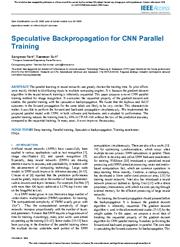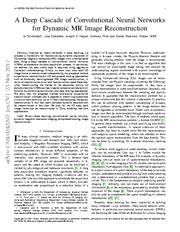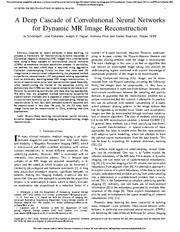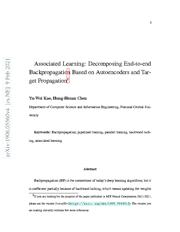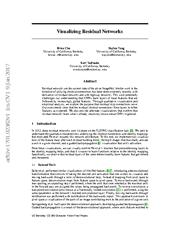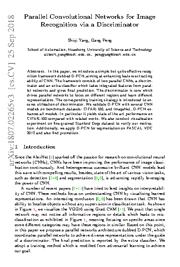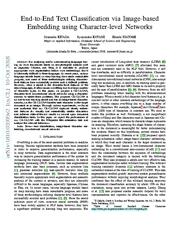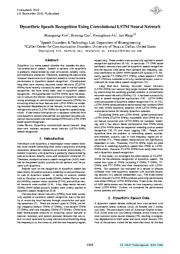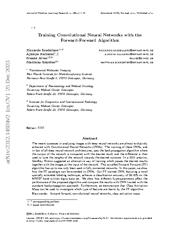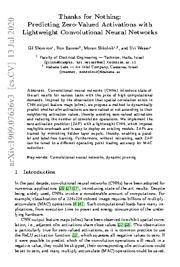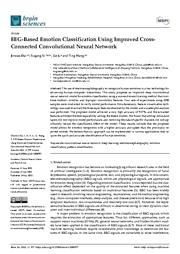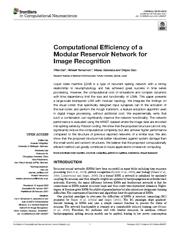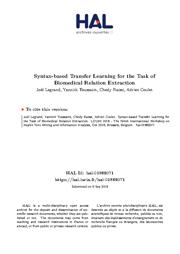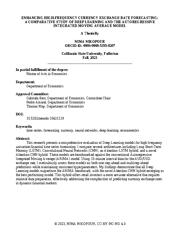A copy of this work was available on the public web and has been preserved in the Wayback Machine. The capture dates from 2020; you can also visit the original URL.
The file type is application/pdf.
Filters
Speculative Backpropagation for CNN Parallel Training
2020
IEEE Access
Thus far, all the ingredients for the speculative backpropagation for the CNNs have been addressed.
V. ...
CONCLUSION In this paper, we proposed a novel CNN parallel training architecture for image recognition. ...
doi:10.1109/access.2020.3040849
fatcat:pbnnwcmxwncgzpn3nw5e2gy4ty
A Deep Cascade of Convolutional Neural Networks for Dynamic MR Image Reconstruction
[article]
2017
arXiv
pre-print
neural networks (CNNs) to accelerate the data acquisition process. ...
Inspired by recent advances in deep learning, we propose a framework for reconstructing dynamic sequences of 2D cardiac magnetic resonance (MR) images from undersampled data using a deep cascade of convolutional ...
We trained the network for 3 × 10 4 backpropagations and the result is denoted as CNN-AD (green curve). ...
arXiv:1704.02422v2
fatcat:owrzheosyjggjgbxqqp3lidqda
A Deep Cascade of Convolutional Neural Networks for Dynamic MR Image Reconstruction
2018
IEEE Transactions on Medical Imaging
For more information, see ...
neural networks (CNNs) to accelerate the data acquisition process. ...
We trained the network for 3 × 10 4 backpropagations and the result is denoted as CNN-AD (green curve). ...
doi:10.1109/tmi.2017.2760978
pmid:29035212
fatcat:g4hq6kemrnf5tlcmdbvlwoxnqe
Associated Learning: Decomposing End-to-end Backpropagation based on Auto-encoders and Target Propagation
[article]
2021
arXiv
pre-print
Specifically, this pipeline structure improves the complexity of the training time from O(nl), which is the time complexity when using BP and stochastic gradient descent (SGD) for training, to O(n + l) ...
Consequently, it is challenging to apply parallel computing or a pipeline structure to update the weights in different layers simultaneously. ...
We thank the reviewers for their informative feedback. ...
arXiv:1906.05560v4
fatcat:canrjhhoxzcxdi2iydkzkk47fy
Visualizing Residual Networks
[article]
2017
arXiv
pre-print
This work potentially challenges our understanding that CNNs learn layers of local features that are followed by increasingly global features. ...
We also provide alternate visualizations that confirm that residual networks learn what is already intuitively known about CNNs in general. ...
Thanks Alyosha and Deepak for comments during the poster session. What is Cory Hall? ...
arXiv:1701.02362v1
fatcat:dpvl2r4shbhr5m6rpu5lymzurm
Parallel Convolutional Networks for Image Recognition via a Discriminator
[article]
2018
arXiv
pre-print
The framework consists of two parallel CNNs, a discriminator and an extra classifier which takes integrated features from parallel networks and gives final prediction. ...
The corresponding training strategy is introduced to ensures utilization of discriminator. ...
Speculating on how to strengthen ability of existed CNN models is a feasible approach. ...
arXiv:1807.02265v3
fatcat:iz435tga6rhy3dssiiabpeiuk4
End-to-End Text Classification via Image-based Embedding using Character-level Networks
[article]
2018
arXiv
pre-print
For analysing and/or understanding languages having no word boundaries based on morphological analysis such as Japanese, Chinese, and Thai, it is desirable to perform appropriate word segmentation before ...
Through various experiments, we found and confirmed that our CE-CLCNN captured closely embedded features for visually and semantically similar characters and achieves state-of-the-art results on several ...
For training of the model, we split the dataset into the training and testing set with an 8:2 ratio, respectively. ...
arXiv:1810.03595v2
fatcat:43yhkxnnanh5nfh2xrzbuzje44
Dysarthric Speech Recognition Using Convolutional LSTM Neural Network
2018
Interspeech 2018
We hypothesized CLSTM-RNNs have the potential to capture the distinct characteristics of dysarthric speech, taking advantage of convolutional neural networks (CNNs) for extracting effective local features ...
and LSTM-RNNs for modeling temporal dependencies of the features. ...
The parameters were trained using backpropagation through time. For CLSTM-RNN, we used the same structure of CNN and replaced the fully connected layer with 2 LSTM-RNN layers. ...
doi:10.21437/interspeech.2018-2250
dblp:conf/interspeech/KimCAW18
fatcat:pth7u5r7onfyzclnyo5oxvvud4
Training Convolutional Neural Networks with the Forward-Forward algorithm
[article]
2024
arXiv
pre-print
We show how different hyperparameters affect the performance of the proposed algorithm and compare the results with CNN trained with the standard backpropagation approach. ...
The training of these CNNs, and in fact of all deep neural network architectures, uses the backpropagation algorithm where the output of the network is compared with the desired result and the difference ...
Figure 3 : 3 Figure 3: The best MNIST performance of an FF-trained CNN architecture is comparable to the results of a backpropagation trained CNN of the same architecture. ...
arXiv:2312.14924v3
fatcat:fotulean3rgeziq6qj43iwlvl4
D-PCN: Parallel Convolutional Networks for Image Recognition via a Discriminator
[article]
2018
arXiv
pre-print
The framework consists of two parallel CNNs, a discriminator and an extra classifier which takes integrated features from parallel networks and gives final prediction. ...
Additionally, we apply D-PCN for segmentation on PASCAL VOC 2012 and also find promotion. ...
Speculating on how to strengthen ability of existed CNN models is a feasible approach. ...
arXiv:1711.04237v3
fatcat:qgtyugujwneshcnezyprv55bhu
Thanks for Nothing: Predicting Zero-Valued Activations with Lightweight Convolutional Neural Networks
[article]
2020
arXiv
pre-print
ZAPs are trained by mimicking hidden layer ouputs; thereby, enabling a parallel and label-free training. ...
Convolutional neural networks (CNNs) introduce state-of-the-art results for various tasks with the price of high computational demands. ...
Acknowledgments We acknowledge the support of NVIDIA Corporation for its donation of a Titan V GPU used for this research. ...
arXiv:1909.07636v3
fatcat:4f4vh6y6o5at3a7c7zwbxxwsr4
EEG-Based Emotion Classification Using Improved Cross-Connected Convolutional Neural Network
2022
Brain Sciences
This study proposes an improved deep convolutional neural network model for emotion classification using a non-end-to-end training method that combines bottom-, middle-, and top-layer convolution features ...
The use of electroencephalography to recognize human emotions is a key technology for advancing human–computer interactions. ...
Acknowledgments: We thank the Hangzhou Mingzhou Naokang Rehabilitation Hospital and medical staff for their help in this study. ...
doi:10.3390/brainsci12080977
pmid:35892418
pmcid:PMC9394254
fatcat:xgf2dn26tfczterqqdfwftzn7u
Computational Efficiency of a Modular Reservoir Network for Image Recognition
2021
Frontiers in Computational Neuroscience
Compared to traditional RNNs, RC saves the resource for backpropagation. ...
Therefore, hardware-based parallelization speedup could be a promising direction for LSMs. ...
doi:10.3389/fncom.2021.594337
pmid:33613220
pmcid:PMC7892762
fatcat:lp5ltnvnsnaf5ldu63rul4ngoq
Syntax-based Transfer Learning for the Task of Biomedical Relation Extraction
2018
Proceedings of the Ninth International Workshop on Health Text Mining and Information Analysis
In particular, domain adaptation consists, for a specific task, in reusing training data developed for the same task but a distinct domain. ...
exist for side domains. ...
All parameters (weights, biases and embeddings) were iteratively updated via backpropagation for the MCCNN and backpropagation Through Structure (Goller and Kuchler, 1996) for the TreeL-STM. ...
doi:10.18653/v1/w18-5617
dblp:conf/acl-louhi/LegrandTRC18
fatcat:darkxdyi3jfxtfdapuxe2hhlta
ENHANCING HIGH-FREQUENCY CURRENCY EXCHANGE RATE FORECASTING: A COMPARATIVE STUDY OF DEEP LEARNING AND THE AUTOREGRESSIVE INTEGRATED MOVING AVERAGE MODEL
2023
Zenodo
I compare several architectures including Long Short-Term Memory (LSTM), Convolutional Neural Networks (CNN), an Attention-LSTM hybrid, and a novel Attention-CNN hybrid. ...
This research presents a comprehensive evaluation of Deep Learning models for high-frequency univariate financial time series forecasting. ...
of the training set being used for validation during training. ...
doi:10.5281/zenodo.10421119
fatcat:gynbgjg43fgzjfnp5b3h6tndqe
« Previous
Showing results 1 — 15 out of 570 results

